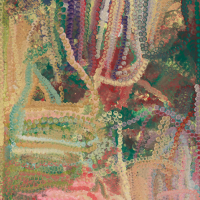43. EMILY KAME KNGWARREYE

Emily Kame Kngwarreye lived her entire life in one of the worlds most remote regions, an area called Utopia on the edge of the Simpson Desert. It was here that Kngwarreye began to paint on canvas for the first time at almost eighty years of age, after a lifetime of transient mark-making in sand and on bodies.
Kngwarreyes paintings transcend her relative physical and artistic isolation. As Professor Margo Neale describes, she was elderly, black, female and untutored in the art practices of the western art world, where her works were unconditionally accepted, voraciously consumed and elevated to iconic status.1 Kngwarreyes practice drew instant acclaim as the cutting edge of Aboriginal art because she did not conform to the conventional coded system of Indigenous iconography, instead producing large abstract canvases. These works came at a time when Aboriginal art had broken free of its label as tribal or primitive art, finally reaching the rarefied status of contemporary fine art. In a global context Kngwarreyes works were instantly aligned with major abstract painters of the twentieth century, such as Jackson Pollock (1912-1956) and Willem de Kooning (1904-1997), despite Kngwarreye never having been exposed to these influences. Remarkably, while her works can hold their own against such revered Abstract Expressionists, her masterpieces owe nothing to Western art history and everything to her pure talent and intuition which derive from local Aboriginal practices.
Although Kngwarreyes oeuvre can be split into various stylistic chapters, the entirety of her work speaks of her Country, Alhalkere. So profound and all-encompassing was her identification with Alhalkere, that it was not only her studio, but also her constant source of inspiration and her sole subject. The only definitive statement she reportedly ever made about her work was, whole lot, thats whole lot thats what I paint, whole lot,2 suggesting her works embody every aspect of Alhalkere, from the contours of the country to the cycles of the seasons.
The present work is no exception, portraying the life force of her Country and the dynamic growth after rain. It is widely agreed that the period between 1991 and 1993, when Yam Country was painted, was Kngwarreyes greatest colourist phase.3 The dull greens represent the new life following the wet season, which Kngwarreye referred to as green time, and the warm yellows signifying bursting seeds including those of the yam plant. The artist spent much of her life digging up the atnwelarr (pencil yam), with its green leaves, yellow flowers, and edible roots. In fact, her middle name Kame refers to the seeds and flowers of the pencil yam. This custom of naming a person after a particular part of a Dreaming further emphasises the individuals connection to their Country.4
Dots are of course a hallmark of contemporary desert art, but few artists have used them as innovatively as Kngwarreye. Yam Country demonstrates her inventive technique known as the dump-dump style.5 Here, Kngwarreye used a paintbrush swiftly and with such force that the bristles splayed dramatically, leaving marks with feathered edges and hollow centres, each one a petrified imprint of the original action. Occasionally she even cut off the end of paintbrush bristles to strengthen this effect. This resourcefulness and creativity are what led her to become one of Australias finest abstract painters. A year prior to painting Yam Country she received the Australian Artists Creative Fellowship, and four years later she represented Australia posthumously at the 1997 Venice Biennale
Footnotes
1. Neale, M. et al., Emily Kame Kngwarreye: Utopia: The Genius of Emily Kame Kngwarreye, The National Museum of Australia, Canberra, 2008, p.33
2. Ibid, p.37
3. Isaacs, J., Smith, T., and Ryan, J., et al., Emily Kngwarreye Paintings, Craftsman House, Sydney, 1998, p.31
4. Cubillo, F., and Caruana W. (eds.), Aboriginal and Torres Strait Islander Art: Collection Highlights, National Gallery of Australia, Canberra, 2010
5. Neale, M. et al., Emily Kame Kngwarreye: Utopia: The Genius of Emily Kame Kngwarreye, p. 40
Asta Cameron BA, MA (Art Curatorship)